Peru Diary 6
Oct 7
Overnight we had had thunder and heavy rain, but by the time we went
out there was only the isolated drop of rain. A general strike was
planned in Peru today to protest at rising prices. This did not seem to
have any impact in Puno although we avoided the University area where
roadblocks were expected. We visited the market first, and I was
surprised at how friendly everyone seemed to be given that we were
clearly tourists unlikely to buy anything and putting our noses and
cameras into every corner. Some of the green vegetable looked a bit
tired, but the other produce, from live fish to bags of potato
varieties and Andean roots, looked very appetising.
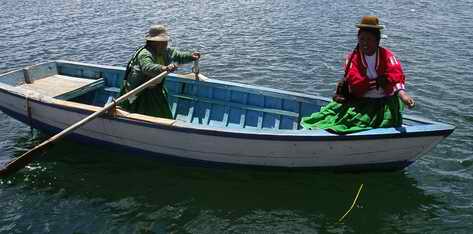 After this we
headed for the Yavari restored steamship for another dose of Peruvian
wisdom (for me!), and a guided tour of the ship, from the captain.
Again his enthusiasm shone through. The sun had also decided to shine
through, so when we arrived at one of the Uros floating reed islands it
was warm and dry. This visit ended with the group taking a cruise on a
reed boat. After ten minutes it was clear that the two young girls
rowing it around were not exactly in control of the boat! After a
further ten minutes, with time for our visit running short, the guide
Eduardo paid for one of the row-boat 'taxis' to take the mother across
to the drifting boat to take it in hand. Eduardo & I followed in
the motor launch and watched at the 'taxi' pushing the boat towards
another island. Eventually boat the reed boat and our launch moored at
the same island & the group were transferred safely back onto the
launch!
After this we
headed for the Yavari restored steamship for another dose of Peruvian
wisdom (for me!), and a guided tour of the ship, from the captain.
Again his enthusiasm shone through. The sun had also decided to shine
through, so when we arrived at one of the Uros floating reed islands it
was warm and dry. This visit ended with the group taking a cruise on a
reed boat. After ten minutes it was clear that the two young girls
rowing it around were not exactly in control of the boat! After a
further ten minutes, with time for our visit running short, the guide
Eduardo paid for one of the row-boat 'taxis' to take the mother across
to the drifting boat to take it in hand. Eduardo & I followed in
the motor launch and watched at the 'taxi' pushing the boat towards
another island. Eventually boat the reed boat and our launch moored at
the same island & the group were transferred safely back onto the
launch!
Boat
taxi to the rescue!
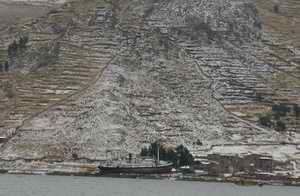 After this it was on
to Tequile Island for a short walk up to the village where we ended up
in a cafe overlooking the beautiful blue water of the lake stretching
towards Bolivia. As the slow process of ordering went on, and the even
longer process of receiving the drinks and food, the skies began to
darken. Chips were swallowed rapidly and the bills hurriedly paid so
that we could walk on to the other side of the island to meet the boat
before the rain came. As we headed into the choppy lake waters we could
see lightning flashing over the area of Puno. When we eventually got to
the Puno landing stage we could see the hills around Puno were white
with hail. The roads around the shore were flooded and people were
shovelling hail off the pavement.
After this it was on
to Tequile Island for a short walk up to the village where we ended up
in a cafe overlooking the beautiful blue water of the lake stretching
towards Bolivia. As the slow process of ordering went on, and the even
longer process of receiving the drinks and food, the skies began to
darken. Chips were swallowed rapidly and the bills hurriedly paid so
that we could walk on to the other side of the island to meet the boat
before the rain came. As we headed into the choppy lake waters we could
see lightning flashing over the area of Puno. When we eventually got to
the Puno landing stage we could see the hills around Puno were white
with hail. The roads around the shore were flooded and people were
shovelling hail off the pavement.
Hail covered terraces above a ship
under restoration at Puno
Oct 8
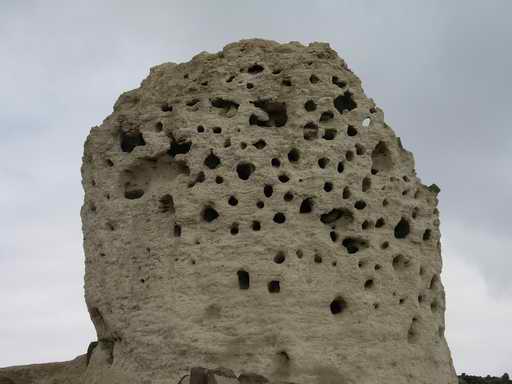 A wet
morning did not bode well, but it stopped as we left Puno heading for
Cuzco. Small piles of hail still lay by the roadside, and the upper
parts of the surrounding hills were still white. Our first stop
was the funeral towers of Sillustani, and on this visit the guide,
Eduardo, took us on a more extended walk, as far as some towers that
were restored in the 1970's with a plaster covering of mud and dung
that had been bleached white by the sun. In the intervening 30 years
the wind and rain had completely removed the plaster from one side, and
the remaining side had been peppered by the holes made by the Andean
Flicker - a woodpecker-like bird!
A wet
morning did not bode well, but it stopped as we left Puno heading for
Cuzco. Small piles of hail still lay by the roadside, and the upper
parts of the surrounding hills were still white. Our first stop
was the funeral towers of Sillustani, and on this visit the guide,
Eduardo, took us on a more extended walk, as far as some towers that
were restored in the 1970's with a plaster covering of mud and dung
that had been bleached white by the sun. In the intervening 30 years
the wind and rain had completely removed the plaster from one side, and
the remaining side had been peppered by the holes made by the Andean
Flicker - a woodpecker-like bird! 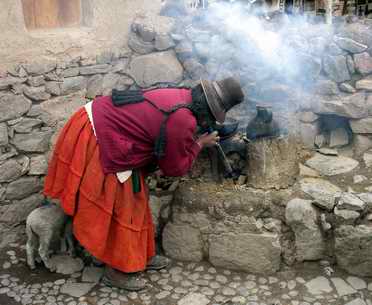
A
pecked tower at Sillustani
Leaving this site after the inevitable shopping (OK, I did buy a
pullover this time) we stopped at the same altoplano farmstead that we
had visited before. This time 'mami' was on hand to demonstrate getting
the cooking fire going with dried llama dung and then Angelica &
Bertha & 'papi' demonstrated how to grind grain and peppers using
stones. Eduardo had a wonderful way of talking with the family and
introducing them; indeed he almost stopped everyone along our travels,
asked them their name, and introduced them to the group. Then
translated, if they happened to be speaking Aymara or Quecha.
Blowing up the kitchen stove
The journey continued into the more mountainous area north of Lake
Titicaca, with puna grass landscape predominating. After reaching
4,300m it was all downhill to Cuzco, with increasing greenness and
eucalyptus trees as we got lower. We were now in the Amazon catchment
area - and by late afternoon quite alot of additional water was falling
in that particular part of the catchment area! We abandoned the planned
visit to Raqchi & headed on to Cuzco, arriving just as it was
getting dark and just before a particularly heavy downpour.
Oct 9
What's this? Waking up to rain? Oh dear, we had hit the rainy season.
This meant that today's trail around the Inca sites near to Cuzco,
and to various spots within Cuzco, was interrupted now and then
by a hefty downpour!
 Panorama of Saqsaywaman, taken on a
sunnier day!
Panorama of Saqsaywaman, taken on a
sunnier day!
This only really affected the visit to Saqsaywaman where we did not
climb up through the zig-zag walls of the 'fortress' area, but scurried
under the huge blocks that make up the lower tier of the walls and back
down to the car park. Curiously a number of people suddenly appeared
selling plastic ponchos in addition to stone carvings. After a few
minutes of rain the site was dotted with pastel shades of pink and blue
plastic as visitors donned their new purchases! 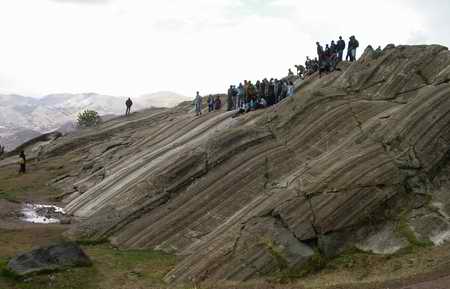
High
school students on the rock slide
However, the biggest number of visitors was a large group of high
school students who had now apparently finished their studies, and were
celebrating noisily with group photos and sliding down the polished
rocks above the main amphitheatre area.
Rather than walking down to the city we took the mini-bus, and then
split for lunch around the Plaza de Armas & met up again for the
afternoon's tour of the Cathedral and Qoricancha, the Temple of the Sun
on which the Spanish built the Santo Domingo Church. Out of the
back of the Santo Domingo cloisters there was a view down to where the
river used to be, now the main Avenida del Sol, and a small
extraordinary garden. This was all part of the original Inka temple
site, constructed on a hill between two rivers, and with water channels
running down the terraces and across the flat area which now covers the
underground Qoricancha museum. I returned here after the guide Ubaldo
had taken us around the site and found the best tended patch of garden
I have seen in Peru (and with a humming bird visiting too) - a
rectangular bed filled with fuschias, large fennel-like plants and
Peru's national flower - a feast of colour, and a superb foreground for
a photo - if only the background of Cuzco city outskirts looked more
interesting, and if only I had had my camera!.
Below this there was a small lawn which had been cut to leave the 3
Inka symbols of the condor (the heavens), the puma (the earth) and the
snake (the underworld).
The evening was livened by the live entertainment accompanying the
evening meal at La Retama restaurant. This included a dance with the
Ukoko figure, who has a white (knitted) mask giving a ghostly
clown-like appearance - I must find out what it all means. I bought a
CD despite the inclusion of Guantanamera on the disk. At least 'Let it
Be' or 'Imagine' or the William Tell Overture were excluded...
Oct 10

A free day in Cuzco, and time to stroll around the streets of the
centre and the arty district of San Blas. From the square by the adobe
church of San Blas there was a fine view over the city and the
surrounding hills. Like many hills close to towns there is a variety of
adverts and logos picked out by stones or vegetation on the slopes -
some commercial, some for local schools or institutes, and others just
a sort of propaganda.
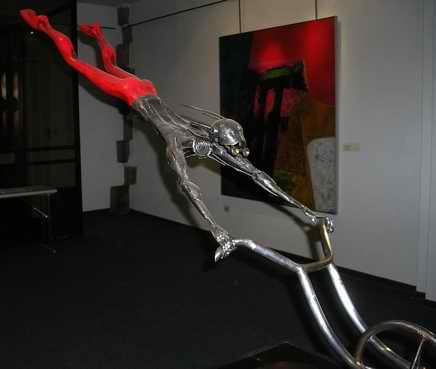 Down in the town I
revisited the Museum of Contemporary Art in order to photograph my
favourite exhibit - Mercury, flying past on a single wheel
and handlebars.
Down in the town I
revisited the Museum of Contemporary Art in order to photograph my
favourite exhibit - Mercury, flying past on a single wheel
and handlebars.
Logos on a Cuzco hillside
Mercury
Oct 11
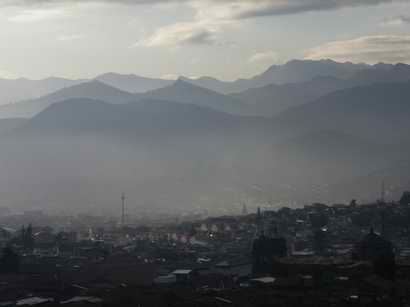 Machu Picchu day,
so a very early start at 05.30 to catch the 06.05 train. As the train
switchbacked up the hill out of Cuzco there were beautiful misty views
over Cuzco
at sunrise. A striking contrast to the litter strewn track! As we
crossed the Cuzco plateau before winding down the gorge to the Urubamba
river we could see the glaciers and snow of the distant Cordillera -
the main peak ahead of us being the strangely named 'Veronica' - of
course it has a Quechua name, but that doesn't appear on the map.
Machu Picchu day,
so a very early start at 05.30 to catch the 06.05 train. As the train
switchbacked up the hill out of Cuzco there were beautiful misty views
over Cuzco
at sunrise. A striking contrast to the litter strewn track! As we
crossed the Cuzco plateau before winding down the gorge to the Urubamba
river we could see the glaciers and snow of the distant Cordillera -
the main peak ahead of us being the strangely named 'Veronica' - of
course it has a Quechua name, but that doesn't appear on the map.
There were no delays on the train (this time) so we had four hours at
Machu Picchu - two hours of which was spent following Ubaldo, the
guide, round the site trying to stay vaguely together as a group in the
face of the severe group traffic in the opposite or cross directions.
You have to imagine, as at Stonehenge, what the spiritual effect would
be if you were alone on the site. Even with the hundreds of visitors
the effect of impossibly perfect 'sculpted' stone walls set high on a
mountain in the jungle is stunning. While the group was
finishing a picnic on one of the top terraces I legged it up the Inca
trail to the Sun Gate to see the view back to Machu Picchu and Huana
Picchu. Despite the sweat, it was worth it! 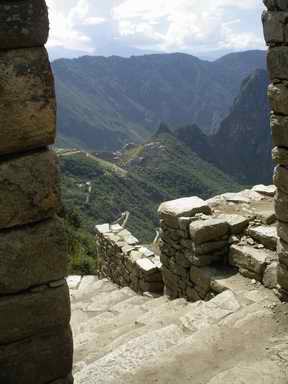
Cuzco just after dawn
Back on the train after far too short a time on the site the
journey seemed to take forever - at one point as it was getting dark,
and the almost full moon was showing above the hillside, the train
slowed to snail's pace and then shuddered to a halt. We were somewhat
bemused as the train driver/engineer climbed onto the roof of the
engine with a large plastic bucket! Whatever he did worked and we soon
on our way, entertained as on the last trip by the serving staff
putting on a fashion show.
Machu
Picchu from the Sun Gate
Oct 12
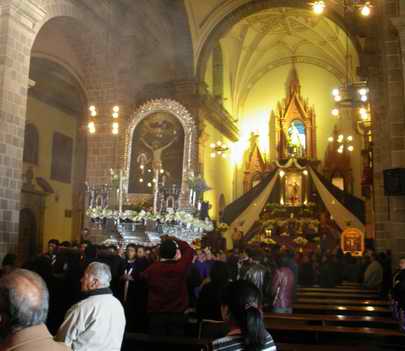 Our last day in Cuzco
began for me with a rapid visit to the San Francisco church where their
purple-clad Virgin Mary was to be paraded round the town. As I arrived
the congregation were just giving a round of applause as the huge
statue was lifted up and steered to the aisle by the twenty or so men
carrying it. The air was being polluted by a number of incense swinging
ladies walking backwards before the statue. As it was carried out of
the church, accompanied by singing, a band of mainly young
musicians started playing a slow dirge-like typically Spanish
processional music. I was particularly impressed by the bright red
tubas at the back of the parade.
Our last day in Cuzco
began for me with a rapid visit to the San Francisco church where their
purple-clad Virgin Mary was to be paraded round the town. As I arrived
the congregation were just giving a round of applause as the huge
statue was lifted up and steered to the aisle by the twenty or so men
carrying it. The air was being polluted by a number of incense swinging
ladies walking backwards before the statue. As it was carried out of
the church, accompanied by singing, a band of mainly young
musicians started playing a slow dirge-like typically Spanish
processional music. I was particularly impressed by the bright red
tubas at the back of the parade.
I only watched a short part of the parade, noticing on the way back to
the hotel, and breakfast, that the Cuzco Lions club had decorated a
doorway in purple ribbons and balloons on the parade route - and then
noticing lots of other doorways similarly decorated by other
organisations. The rush back was because we were departing with Ubaldo
at 08.00 to visit Ollantaytambo and Pisaq - a couple of Inca sites that
match Machu Picchu in scale and interest, but without mountainous
jungle and difficult access.
The Virgin being carried out of San
Francisco Church.
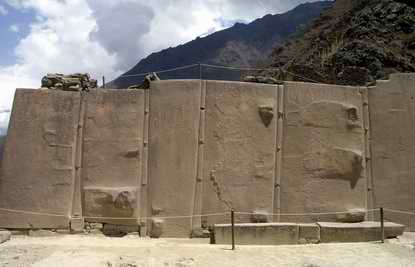
Just as at Machu Picchu you cannot help but be amazed at the elegance
stonework in the temple areas and the lengths to which the Incas went
to get the right stone - in the case of Ollantaytambo the stone came
from across the Urubamba River, which they diverted around the stones
in order to cross the river. At Pisaq the site is four times bigger
than Machu Picchu and the trail linking parts of the site skirts a very
steep drop and at one point goes through a semi-natural cave in the
rock. It made a fabulous walk in the afternoon sunshine with, surprise,
surprise, the odd Peruvian piper popping up now and then with squeaky
versions of El Condor Paso.
Stonework
in the temple area of Ollantaytambo
Back to Peru Trip Index
 After this we
headed for the Yavari restored steamship for another dose of Peruvian
wisdom (for me!), and a guided tour of the ship, from the captain.
Again his enthusiasm shone through. The sun had also decided to shine
through, so when we arrived at one of the Uros floating reed islands it
was warm and dry. This visit ended with the group taking a cruise on a
reed boat. After ten minutes it was clear that the two young girls
rowing it around were not exactly in control of the boat! After a
further ten minutes, with time for our visit running short, the guide
Eduardo paid for one of the row-boat 'taxis' to take the mother across
to the drifting boat to take it in hand. Eduardo & I followed in
the motor launch and watched at the 'taxi' pushing the boat towards
another island. Eventually boat the reed boat and our launch moored at
the same island & the group were transferred safely back onto the
launch!
After this we
headed for the Yavari restored steamship for another dose of Peruvian
wisdom (for me!), and a guided tour of the ship, from the captain.
Again his enthusiasm shone through. The sun had also decided to shine
through, so when we arrived at one of the Uros floating reed islands it
was warm and dry. This visit ended with the group taking a cruise on a
reed boat. After ten minutes it was clear that the two young girls
rowing it around were not exactly in control of the boat! After a
further ten minutes, with time for our visit running short, the guide
Eduardo paid for one of the row-boat 'taxis' to take the mother across
to the drifting boat to take it in hand. Eduardo & I followed in
the motor launch and watched at the 'taxi' pushing the boat towards
another island. Eventually boat the reed boat and our launch moored at
the same island & the group were transferred safely back onto the
launch! After this it was on
to Tequile Island for a short walk up to the village where we ended up
in a cafe overlooking the beautiful blue water of the lake stretching
towards Bolivia. As the slow process of ordering went on, and the even
longer process of receiving the drinks and food, the skies began to
darken. Chips were swallowed rapidly and the bills hurriedly paid so
that we could walk on to the other side of the island to meet the boat
before the rain came. As we headed into the choppy lake waters we could
see lightning flashing over the area of Puno. When we eventually got to
the Puno landing stage we could see the hills around Puno were white
with hail. The roads around the shore were flooded and people were
shovelling hail off the pavement.
After this it was on
to Tequile Island for a short walk up to the village where we ended up
in a cafe overlooking the beautiful blue water of the lake stretching
towards Bolivia. As the slow process of ordering went on, and the even
longer process of receiving the drinks and food, the skies began to
darken. Chips were swallowed rapidly and the bills hurriedly paid so
that we could walk on to the other side of the island to meet the boat
before the rain came. As we headed into the choppy lake waters we could
see lightning flashing over the area of Puno. When we eventually got to
the Puno landing stage we could see the hills around Puno were white
with hail. The roads around the shore were flooded and people were
shovelling hail off the pavement. A wet
morning did not bode well, but it stopped as we left Puno heading for
Cuzco. Small piles of hail still lay by the roadside, and the upper
parts of the surrounding hills were still white. Our first stop
was the funeral towers of Sillustani, and on this visit the guide,
Eduardo, took us on a more extended walk, as far as some towers that
were restored in the 1970's with a plaster covering of mud and dung
that had been bleached white by the sun. In the intervening 30 years
the wind and rain had completely removed the plaster from one side, and
the remaining side had been peppered by the holes made by the Andean
Flicker - a woodpecker-like bird!
A wet
morning did not bode well, but it stopped as we left Puno heading for
Cuzco. Small piles of hail still lay by the roadside, and the upper
parts of the surrounding hills were still white. Our first stop
was the funeral towers of Sillustani, and on this visit the guide,
Eduardo, took us on a more extended walk, as far as some towers that
were restored in the 1970's with a plaster covering of mud and dung
that had been bleached white by the sun. In the intervening 30 years
the wind and rain had completely removed the plaster from one side, and
the remaining side had been peppered by the holes made by the Andean
Flicker - a woodpecker-like bird! 
 Panorama of Saqsaywaman, taken on a
sunnier day!
Panorama of Saqsaywaman, taken on a
sunnier day!

 Down in the town I
revisited the Museum of Contemporary Art in order to photograph my
favourite exhibit - Mercury, flying past on a single wheel
and handlebars.
Down in the town I
revisited the Museum of Contemporary Art in order to photograph my
favourite exhibit - Mercury, flying past on a single wheel
and handlebars.  Machu Picchu day,
so a very early start at 05.30 to catch the 06.05 train. As the train
switchbacked up the hill out of Cuzco there were beautiful misty views
over Cuzco
at sunrise. A striking contrast to the litter strewn track! As we
crossed the Cuzco plateau before winding down the gorge to the Urubamba
river we could see the glaciers and snow of the distant Cordillera -
the main peak ahead of us being the strangely named 'Veronica' - of
course it has a Quechua name, but that doesn't appear on the map.
Machu Picchu day,
so a very early start at 05.30 to catch the 06.05 train. As the train
switchbacked up the hill out of Cuzco there were beautiful misty views
over Cuzco
at sunrise. A striking contrast to the litter strewn track! As we
crossed the Cuzco plateau before winding down the gorge to the Urubamba
river we could see the glaciers and snow of the distant Cordillera -
the main peak ahead of us being the strangely named 'Veronica' - of
course it has a Quechua name, but that doesn't appear on the map.
 Our last day in Cuzco
began for me with a rapid visit to the San Francisco church where their
purple-clad Virgin Mary was to be paraded round the town. As I arrived
the congregation were just giving a round of applause as the huge
statue was lifted up and steered to the aisle by the twenty or so men
carrying it. The air was being polluted by a number of incense swinging
ladies walking backwards before the statue. As it was carried out of
the church, accompanied by singing, a band of mainly young
musicians started playing a slow dirge-like typically Spanish
processional music. I was particularly impressed by the bright red
tubas at the back of the parade.
Our last day in Cuzco
began for me with a rapid visit to the San Francisco church where their
purple-clad Virgin Mary was to be paraded round the town. As I arrived
the congregation were just giving a round of applause as the huge
statue was lifted up and steered to the aisle by the twenty or so men
carrying it. The air was being polluted by a number of incense swinging
ladies walking backwards before the statue. As it was carried out of
the church, accompanied by singing, a band of mainly young
musicians started playing a slow dirge-like typically Spanish
processional music. I was particularly impressed by the bright red
tubas at the back of the parade.